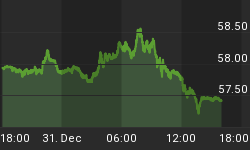The oil price is hitting record highs. Gold remains in a bull market, despite its recent decline. Terror and unrest are on the rise. Is there a connection between these markets and world events? Absolutely, and it's intensifying.
Although we're not happy about the reasons why, world events do affect the markets and they provide insight into what's likely coming in the months ahead. And the way things are shaping up, it's going to be very bullish for gold.
Black Gold & Inflation
Saudi Arabia is the world's largest oil producer and it's the only country with enough spare reserves to weather a crisis. This makes Saudi Arabia a target and it's been simmering under the surface. Terrorist attacks have increased in recent months and they urged U.S. citizens to leave following the shooting of five Western workers last month, and again after 22 foreign oil workers were killed last weekend.
This is one reason why the oil price is hitting record highs because of concerns terrorists could target the oil fields, which is already happening in Iraq. So what happens in the Middle East affects all of us and the markets, especially since there's currently less spare oil available than at almost any time in the past 30 years. And if terror attacks continue as we're currently seeing, it's going to keep upward pressure on oil, despite the recent OPEC production boost.
The oil price also has a huge effect on inflation. This month, for instance, producer prices surged at an annual rate of 8.4%, which was the largest rise in a year, following a 6% annualized rise last month. The reason? Higher energy prices and if the oil price rises further, so will inflation. This in turn will send gold higher since gold is the ultimate inflation hedge.
Oil: Poised to Rise Further
Looking at Chart 1A, you can see the oil price is at an all time high and the trend has been up since 1999. During that time, the price has nearly quadrupled.

More impressive, the leading (long-term) indicator is not overbought (see Chart 1B). In fact, it has plenty of room to rise further before it is. So despite the oil price rise we've already seen, this chart is telling us $50-$60 oil is not out of the question. And if that happens, it's going to really affect inflation and gold, especially since other commodities are rising at double-digit levels too.
Plus, as Marc Faber points out, by 2010 India and China will have a combined population of 3 billion people, or 40% of the world's population. And with these countries still in the early stages of economic development and growth rates at 8-9%, demand levels for raw materials are being propelled to heights the world has never seen before. In China alone, the number of cars is increasing by 50% each year. So it's easy to imagine what this could do to the oil price, sending it higher than most people expect.
We believe the inflation seeds have been sown, which explains why bond yields have been rising sharply, stocks are topping, gold remains bullish and the U.S. dollar is bearish. How high inflation goes remains to be seen, but with Iraq now costing nearly $7 billion a month and heading for an overall cost more than double that of the first Gulf war, inflation could surprise on the upside as the U.S. intensifies its deficit spending and money supply growth, which are already soaring.
So Why Has Gold Been So Week?
Gold is a cyclical and seasonal market. It tends to be soft in the Spring and early Summer months until demand picks up as manufacturers begin buying for the holidays. Our leading (medium-term) indicator on Chart 2B captures these moves well.

Gold's intermediate moves are labeled as A-D on the chart. The As and Cs coincide with gold rises while the Bs and Ds coincide with the declines. As you can see, gold has been in an intermediate D decline since January. The rise in March, in hindsight, was part of a topping process in the C peak before gold fell (see Chart 2A). The D decline was then fully expressed as the indicator fell to the low levels that coincide with prior D decline lows. The fall was steep but gold held near the 65-week moving average and it's now bouncing up from this important support. The prior D decline a year ago was similar.
D declines are usually the sharpest intermediate declines in gold's cycle as they wring out the excesses of the previous C rise. In a bull market, the D decline lows will be higher than the prior B low, which is exactly what happened.
This D decline lasted on the longer side of a normal D decline but since the dollar's rebound rise is now over, these markets are now in synch to resume their major trends. This means gold's A rise is now getting started as long as gold stays above $385.
A rises tend to be consolidation rises. In other words, they generally rise to test the highs but they don't usually rise to new highs. So if gold closes and stays above $400, it could rise to $430. And if this is all we get for now, the bull market will still be very solid. The A rise could last until July. If gold breaks clearly above $430 during this rise, then it would be super strong because gold would be entering a stronger phase of the bull market.
More important, it's good to know the worst is over for this year assuming the bull market stays intact. And it will as long as gold stays above its 65-week moving average at $377. This means if we don't see a new high until the Fall, gold will still be fine and on track.
















